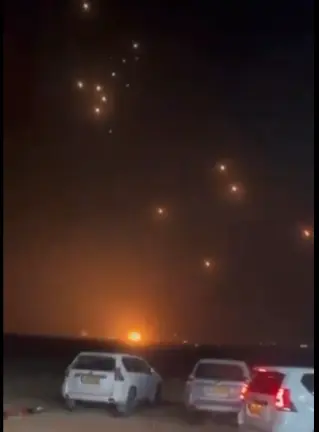Iran Prepares “Definitive” Retaliation from Iraq Following Israel’s Direct Strikes: An Escalating Cycle of Confrontation

TL;DR
Following direct Israeli airstrikes on Iranian targets in April and October, recent intelligence suggests Iran is preparing a major retaliatory strike from Iraqi territory, likely involving drones and ballistic missiles launched by pro-Iranian militias. This response, anticipated before the U.S. Presidential Election, underscores Iran’s intent to avoid direct confrontation on its own soil while maintaining pressure on Israel. The escalation marks a shift from proxy engagements to a cycle of direct confrontations, raising tensions across the region and involving U.S. strategic interests.
Israel-Iran Tensions Escalate with Anticipated Retaliation from Iraq
Following two direct Israeli strikes on Iranian territory this year—in April and most recently on October 26—new intelligence suggests that Iran is preparing a significant retaliatory strike against Israel. Reports from Axios indicate that this response could be launched from Iraqi territory through pro-Iranian militias, using drones and ballistic missiles to target strategic Israeli locations. The timing of the anticipated strike, potentially before the U.S. Presidential Election on November 5, highlights the high stakes of the situation as tensions surge in the Middle East.
The Israeli airstrikes within Iran marked a rare but growing tactic, reflecting Israel’s willingness to bypass proxy targets in Syria and Iraq and instead directly degrade Iran’s military infrastructure. By focusing on missile production sites and air defenses, these recent strikes were intended to prevent Iran from projecting greater force in the region, a threat Israel views as increasingly urgent following the October 1 missile attack on Israel launched from Iran. In this latest escalation, Israel's Defense Minister stated that the strikes were aimed at deterring further Iranian aggression and disabling Iran’s missile capabilities, though the effectiveness remains under watch as Iran’s retaliatory strategy unfolds.
Proxy Strategy in Iraq: A Shield Against Direct Retaliation
Iran’s anticipated strike, using its proxy forces in Iraq rather than launching directly from Iranian soil, reflects a calculated strategy to avoid another direct Israeli attack on its own territory. Iran has long relied on proxy groups, particularly Iraqi militias like Kata’ib Hezbollah and Asa’ib Ahl al-Haq, which operate under the guidance of Iran’s Islamic Revolutionary Guard Corps (IRGC). These groups not only allow Iran to engage in asymmetrical warfare but also provide Tehran with a layer of deniability, reducing the likelihood of immediate direct retaliation.
Using Iraq as a launch point, Iranian leadership likely aims to continue exerting pressure on Israel while minimizing the risk of broader regional conflict. Additionally, Iraq’s geographic position enables Iran to strike Israel from a closer proximity, potentially bypassing some of Israel’s air defenses. Hossein Salami, IRGC commander, further highlighted Iran’s intentions, stating that the forthcoming response will be “different from any scenario” Israel might anticipate, signaling a complex, multi-faceted approach that may extend beyond just a single wave of drone and missile attacks.
The April and October Israeli Strikes: A New Chapter in Israel-Iran Conflict
The escalating Israel-Iran conflict has reached new levels this year. In April 2024, Israel conducted its first widely publicized airstrikes within Iranian territory, targeting key missile infrastructure. Then, in October 2024, Israel launched another significant operation targeting over 20 Iranian sites, including missile production and air defense installations. These actions marked a shift in Israeli strategy, as Israel moved beyond targeting Iranian assets in Syria, Lebanon, and Iraq, bringing the conflict directly to Iran’s doorstep.
These direct strikes were a response to a series of Iranian provocations, including a massive October 1 missile attack on Israel that Tehran labeled as “self-defense.” The IRGC’s October 1 attack, involving approximately 200 ballistic missiles, caused limited damage thanks to Israel’s Iron Dome and David’s Sling defenses but revealed a heightened risk of sustained attacks on Israeli infrastructure. The recent Israeli airstrikes aimed to degrade Iran’s missile production and prevent future attacks of a similar scale, though the cycle of retaliation appears far from over as Iran plans its response.
Regional Implications and U.S. Involvement
As Iran prepares its response from Iraq, the United States is monitoring the situation closely. The potential for escalation directly impacts U.S. strategic interests in the Middle East, where American forces remain stationed in Iraq and other key locations. A U.S. official, speaking to Axios, noted that while Tehran’s exact timeline is uncertain, any significant Iranian action could prompt a swift U.S. response in coordination with Israel. Additionally, the timing—just days before the U.S. election—raises concerns over how this conflict could influence or be influenced by American foreign policy.
The anticipated retaliation also underscores the strategic role that Iranian proxies play in regional conflicts. While Iran uses these groups to maintain its influence, the presence of U.S. forces in Iraq complicates the situation. Any escalation could inadvertently affect American personnel or assets in Iraq, potentially drawing the U.S. further into the conflict. As a result, both the U.S. and Israel are likely heightening their defensive measures and intelligence-sharing efforts to preemptively address any moves by Iran’s proxies in Iraq.
Strategic and Military Impact: Drones, Ballistic Missiles, and Defense Readiness
The use of drones and ballistic missiles by Iranian proxies represents a strategic choice designed to challenge Israel’s missile defense systems. Iran has invested heavily in developing and deploying precision-guided munitions, a capability that has allowed Iranian-backed groups to conduct more effective strikes against well-defended targets. A multi-pronged attack involving drones and missiles would stress Israel’s air defense systems, increasing the chance of bypassing Israeli defenses and reaching critical infrastructure.
Israeli intelligence indicates that it is preparing for such an attack by reinforcing air defense assets and coordinating closely with its intelligence networks. The Iron Dome, David’s Sling, and Arrow systems are likely on high alert, prepared to intercept multiple threats across a wide range of altitudes and velocities. However, the use of saturation tactics by Iran’s proxies may stretch these systems, as seen in prior incidents where layered drone and missile attacks have strained Israel’s air defense grid.
Conclusion: A High-Stakes Anticipation of Retaliation
The anticipated Iranian retaliation signals a dangerous phase in the Israel-Iran conflict, where each nation’s willingness to engage in direct confrontations threatens to further destabilize the region. Iran’s expected response, possibly timed just before the U.S. Presidential Election, reflects a nuanced strategy aiming to maximize impact without inviting immediate direct retaliation on Iranian soil. The choice of Iraqi territory for the launch adds complexity, reducing the likelihood of direct confrontation but increasing regional tensions.
As the situation unfolds, the ongoing cycle of strikes and counter-strikes highlights the escalating nature of this “shadow war” turned open confrontation. This complex web of regional alliances, proxy forces, and advanced weaponry underscores the depth of the Israel-Iran conflict and the broader geopolitical risks that may continue to unfold in the region and beyond.
